- Iran
- Israel-Hamas
-
Topics
FeaturedIntroduction Over the last several decades, governments have collectively pledged to slow global warming. But despite intensified diplomacy, the world is already facing the consequences of climate…
-
Regions
FeaturedIntroduction Throughout its decades of independence, Myanmar has struggled with military rule, civil war, poor governance, and widespread poverty. A military coup in February 2021 dashed hopes for…
Backgrounder by Lindsay Maizland January 31, 2022
-
Explainers
FeaturedDuring the 2020 presidential campaign, Joe Biden promised that his administration would make a “historic effort” to reduce long-running racial inequities in health. Tobacco use—the leading cause of p…
Interactive by Olivia Angelino, Thomas J. Bollyky, Elle Ruggiero and Isabella Turilli February 1, 2023 Global Health Program
-
Research & Analysis
Featured
Terrorism and Counterterrorism
Violence around U.S. elections in 2024 could not only destabilize American democracy but also embolden autocrats across the world. Jacob Ware recommends that political leaders take steps to shore up civic trust and remove the opportunity for violence ahead of the 2024 election season.Contingency Planning Memorandum by Jacob Ware April 17, 2024 Center for Preventive Action
-
Communities
Featured
Webinar with Carolyn Kissane and Irina A. Faskianos April 12, 2023 Academic and Higher Education Webinars
-
Events
FeaturedJohn Kerry discusses his work as U.S. special presidential envoy for climate, the challenges the United States faces, and the Biden administration’s priorities as it continues to address climate chan…
Virtual Event with John F. Kerry and Michael Froman March 1, 2024
- Related Sites
- More
The U.S.–South Korea Alliance
In the past seventy years, the U.S.-South Korea alliance has evolved from a patron-client relationship to a global comprehensive strategic alliance.



The Korean War Begins With North Korea’s Invasion
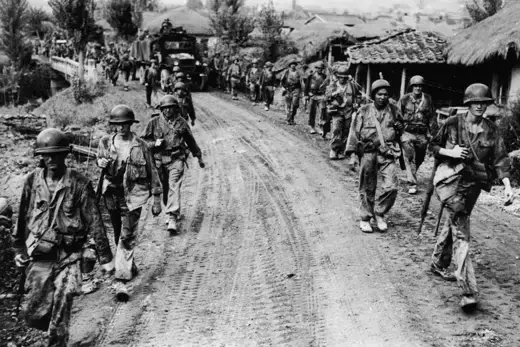
After independence from Japanese colonialism post–World War II, early Cold War tensions lead to the occupation of the Korean Peninsula by Soviet forces in the North and U.S. forces in the South. North Korea, backed by China and the Soviet Union, attempts to reunify the peninsula under communist rule by invading South Korea. The UN Security Council denounces the attack as a breach of peace and adopts binding resolutions, which call for an immediate cessation of hostilities and—for the first time—authorize the formation of the UN Command to provide assistance to South Korea. Under the command, sixteen countries, led by the United States, provide troop support to South Korea.
The United Nations, China, and North Korea Sign the Armistice Agreement
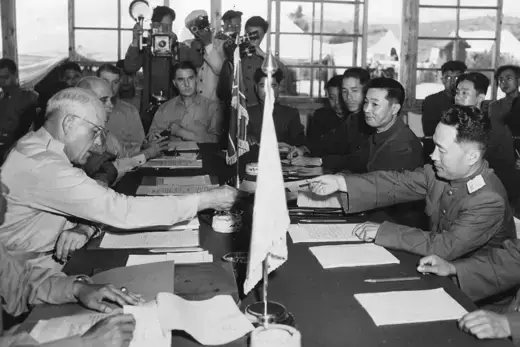
The agreement divides the Korean Peninsula along the thirty-eighth parallel and establishes the Demilitarized Zone (DMZ) as a buffer between North and South Korea. South Korean President Syngman Rhee opts not to sign the agreement, but he accepts the armistice on the condition that the United States and South Korea sign a mutual defense treaty. Because the Armistice Agreement serves as a cease-fire to the Korean War and the two Koreas did not sign a formal peace treaty, they technically remain in a state of war.
The United States and South Korea Sign the Mutual Defense Treaty
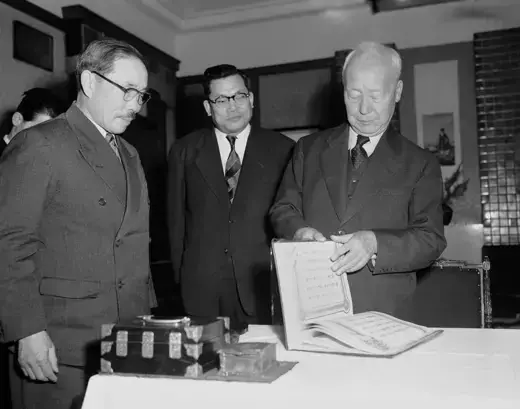
The U.S.-South Korea Mutual Defense Treaty ensures U.S. defense of South Korea against external aggression and commits to a U.S. military presence in South Korea. The treaty lays the foundation for a robust security alliance between the two countries.
General Park Chung-hee Launches a Military Coup
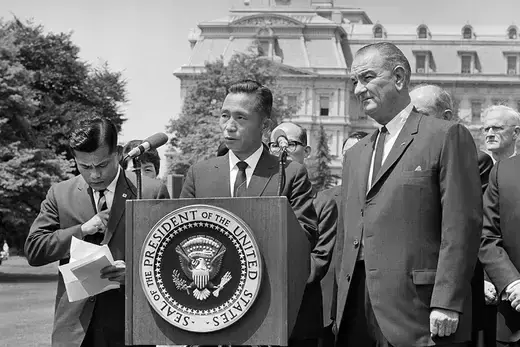
Amid domestic economic and political turmoil, the military overthrows the government, seizes power, and imposes martial law. Under pressure from the United States, South Korea holds a presidential election in 1963, in which Park is elected as president. Park implements an export-oriented economic modernization plan that transforms South Korea from one of the most impoverished countries in the world to a country with unprecedented economic growth, known as the so-called “Miracle on the Han River.” South Korea’s enhanced economic stature begins to alleviate the asymmetry of the U.S.-South Korea relationship.
The United States Discovers South Korea’s Covert Nuclear Weapons Program
President Park initiates the development of an independent nuclear weapons program, following concerns about the United States reducing its security commitment and withdrawing troops from South Korea under the Nixon Doctrine established by U.S. President Richard Nixon. The United States later pressures Park to cancel a nuclear plant agreement with France, offering U.S. nuclear assistance and personnel for peaceful purposes instead. South Korea’s nuclear ambitions cease when Park signs the Nuclear Nonproliferation Treaty (NPT).
Pro-democracy Activists Lead the Gwangju Democratization Movement
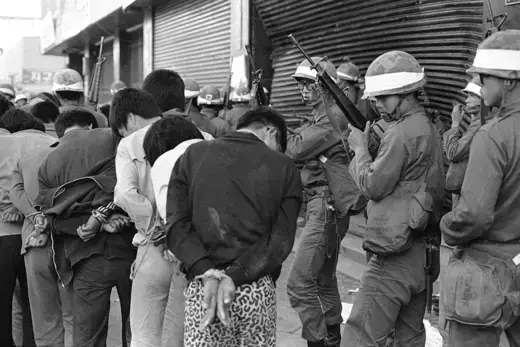
After General Chun Doo-hwan seizes power through a military coup in December 1979, South Korean civilians, led by students and activists, organize pro-democracy protests demanding an end to military rule. The South Korean government responds by imposing martial law and using violence to suppress activists in the city of Gwangju. The movement marks a turning point in South Korea’s struggle for democracy, inspiring people to resist the military dictatorship across the country and eventually leading to the country’s democratization. U.S.-South Korea relations are hobbled by perceptions within South Korea that the United States sided with the dictatorship rather than support the democratic movement.
The United States Withdraws Tactical Nuclear Weapons
U.S. President George H. W. Bush announces his decision to remove all U.S. tactical nuclear weapons from South Korea. The next year, the two Koreas sign the Joint Declaration of the Denuclearization of the Korean Peninsula [PDF]. Under this agreement, the two countries commit not to test, manufacture, produce, receive, possess, store, deploy, or use nuclear weapons.
Anti-American Protests Arise in South Korea

Two off-duty U.S. servicemen accidentally kill two South Korean middle-school girls while driving a U.S. military vehicle. The incident and the subsequent acquittal of the soldiers by a U.S. military court trigger anti-American protests across South Korea. Primarily directed at the U.S. military presence in South Korea, the protests reflect a desire for a more equal relationship with the United States.
North Korea Withdraws From the NPT
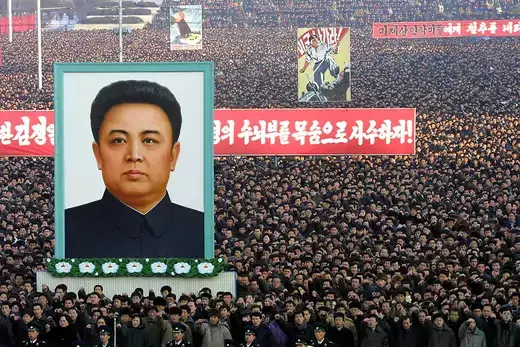
North Korea announces its intention to withdraw from the NPT, stating concerns regarding “hostile” U.S. policies toward the country. Pyongyang criticizes the binding obligations stipulated in the safeguard accord under Article 3 of the International Atomic Energy Agency (IAEA) regulations. Three years later, North Korea successfully tests its first nuclear weapon, changing security dynamics on the Korean Peninsula.
Six-Party Talks Aim to Negotiate North Korea’s Denuclearization
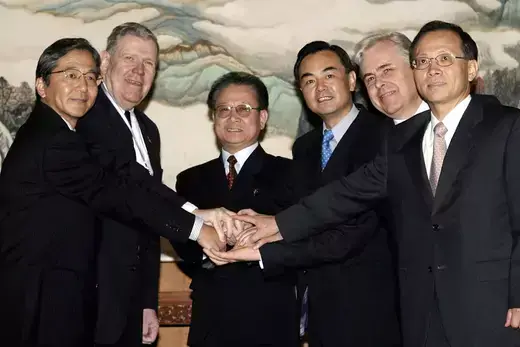
Representatives from China, Japan, North Korea, Russia, South Korea, and the United States convene in Beijing to negotiate North Korea’s denuclearization following revelations that North Korea had covertly pursued a uranium enrichment program. The United States insists on complete, verifiable, and irreversible dismantlement (CVID), while North Korea seeks diplomatic normalization with the United States and security assurances. Despite multiple rounds of talks, the countries fail to reach a consensus, leading to North Korea’s withdrawal from the Six-Party Talks in April 2009 after the UN Security Council condemns its long-range missile launch.
The Korea-United States Free Trade Agreement Enters Into Force
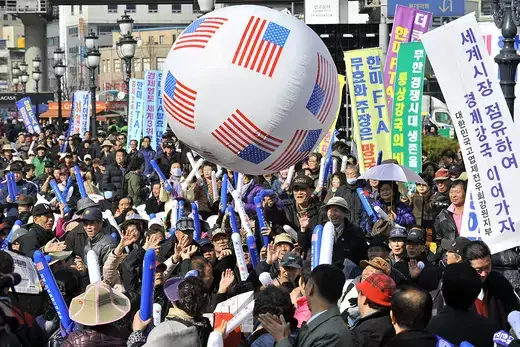
After six years of negotiations, South Korean President Lee Myung-bak and U.S. President Barack Obama sign the trade treaty, which is then ratified by the South Korean National Assembly. The agreement promotes economic cooperation and access to commercial markets for both countries. The Korea-United States Free Trade Agreement (KORUS FTA) is the largest bilateral free trade agreement the United States has signed. The trade agreement paves the way for an economic partnership alongside the military alliance between the two countries.
The United States and South Korea Agree on Space Cooperation
The agreement, established during the second Civil Space Dialogue, aims to promote cooperation in the exploration of outer space for peaceful purposes by both countries. It marks the first space cooperation agreement between the United States and an Asian country.
Moon Jae-in and Donald Trump Hold Their First Summit Meeting

Newly elected South Korean President Moon Jae-in and U.S. President Donald Trump meet in Washington, DC, to address the need for a more balanced trade relationship. Despite concerns regarding diverging policy priorities and potential tensions within the U.S.-South Korea alliance, the two leaders discuss possible revisions to the KORUS FTA, and both express a willingness to engage in dialogue with North Korea under the right conditions.
Kim Jong Un and Moon Jae-in Meet at the DMZ for the Third Inter-Korean Summit
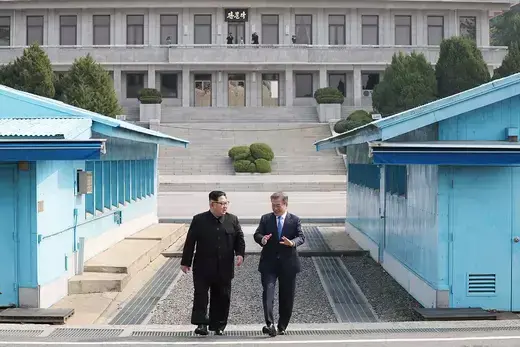
North Korean leader Kim Jong Un and South Korean President Moon Jae-in hold the first inter-Korean leader summit in eleven years. Kim becomes the first North Korean leader to step foot in South Korea since 1953. The two leaders reaffirm their commitment to usher in a new era of inter-Korean relations based on peace, prosperity, and reunification of the Korean Peninsula. They also sign the Panmunjom Declaration, aimed at defusing military tensions and fostering peace on the Korean Peninsula. Two more inter-Korean summits occur in May and September 2018. The September inter-Korean summit held in Pyongyang results in the Pyongyang Joint Declaration, which leads to the adoption of the Agreement on the Implementation of the Historic Panmunjom Declaration in the Military Domain (also known as the Comprehensive Military Agreement, or CMA).
President Trump and Kim Jong Un Meet in Singapore

The two leaders announce a joint statement that commits to establishing new bilateral relations, building a lasting and stable peace regime on the Korean Peninsula, working toward complete denuclearization of the Korean Peninsula, and recovering the remains of U.S. troops unaccounted for during the Korean War. It marks the first bilateral meeting between a sitting U.S. president and the leader of North Korea, which is made possible by President Moon’s efforts to serve as an intermediary between Trump and Kim.
U.S.-North Korea Negotiations Break Down at Hanoi Summit
Trump and Kim meet for a second bilateral summit in Hanoi, Vietnam, to discuss North Korea’s nuclear and missile program and the establishment of a new relationship between the two countries. The two leaders fail to sign a joint statement, both attributing the summit’s breakdown to their inability to resolve differences over North Korean denuclearization measures in exchange for sanctions relief.
Trump Becomes First U.S. President to Set Foot in North Korea
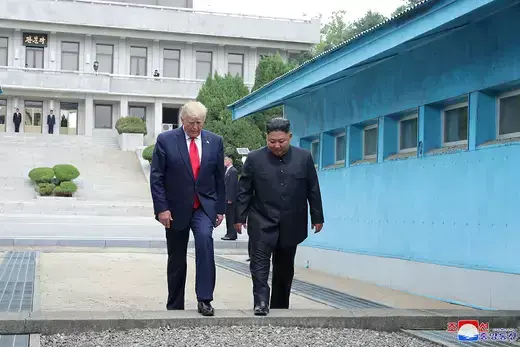
Trump and Kim meet for a third time in the DMZ to resume denuclearization negotiations. South Korean President Moon Jae-in accompanies the two leaders to the Joint Security Area at Panmunjom, where Moon and Kim had met two years earlier. Trump briefly crosses the military demarcation line, becoming the first U.S. president to set foot in North Korea. Despite the two sides expressing commitment to future negotiations, no meaningful steps nor additional summits occur during the remainder of Trump’s term.
President Biden Welcomes President Moon to Washington, DC
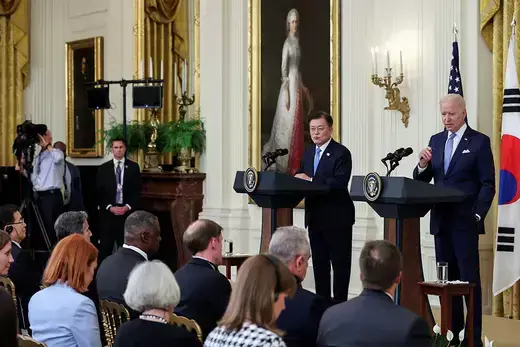
President Moon meets with newly elected U.S. President Joe Biden at the White House, making him the second foreign leader to do so under the new administration after Japanese Prime Minister Suga Yoshihide. The two leaders commit to the coordination of North Korea policy, the termination of South Korea’s Revised Missile Guidelines, the establishment of the United States–South Korea (KORUS) Global Vaccine Partnership, and the preservation of a free and open Indo-Pacific region. The joint statement, for the first time, references the importance of preserving peace and stability in the Taiwan Strait.
The United States and South Korea Strengthen Economic and Technology Partnership
President Biden meets with newly elected South Korean President Yoon Suk Yeol in Seoul only ten days after Yoon’s inauguration. The two leaders reach an agreement to promote resilient global supply chains, enhance public-private partnership to protect critical and emerging technologies such as electric vehicle batteries and semiconductors, support research and development exchanges, and develop collaboration within the Indo-Pacific Economic Framework (IPEF). In addition, the two leaders agree to reactivate the Extended Deterrence Strategy and Consultation Group (EDSCG) to enhance extended deterrence measures.
President Yoon Suk Yeol Makes a State Visit to the United States

To commemorate the seventieth anniversary of the signing of the U.S.-South Korea Mutual Defense Treaty, President Yoon conducts a state visit to Washington, DC. The two leaders announce the Washington Declaration, which outlines enhanced measures to strengthen the U.S. extended deterrence commitment and establishes the Nuclear Consultative Group (NCG). The leaders’ joint statement reaffirms their commitment to broaden bilateral ties, deepen regional engagement, and increase global cooperation for the next seventy years.
First Stand-Alone U.S.-Japan-South Korea Summit Held at Camp David
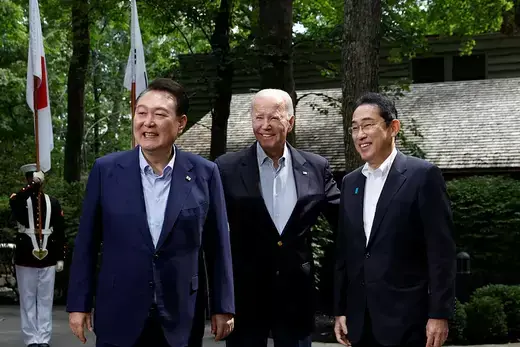
The leaders of the United States, Japan, and South Korea hold an inaugural stand-alone meeting to reaffirm their commitment to trilateral consultations aimed at addressing regional conflicts, North Korea’s expanding threat, and shared interests through annual high-level dialogue meetings. In their efforts to enhance security cooperation, they stress the importance of improving information sharing and coordination on real-time data tracking of North Korean missiles. President Yoon’s efforts to normalize relations with Japan earlier in the year set the stage for strengthened trilateral relations.
 Online Store
Online Store